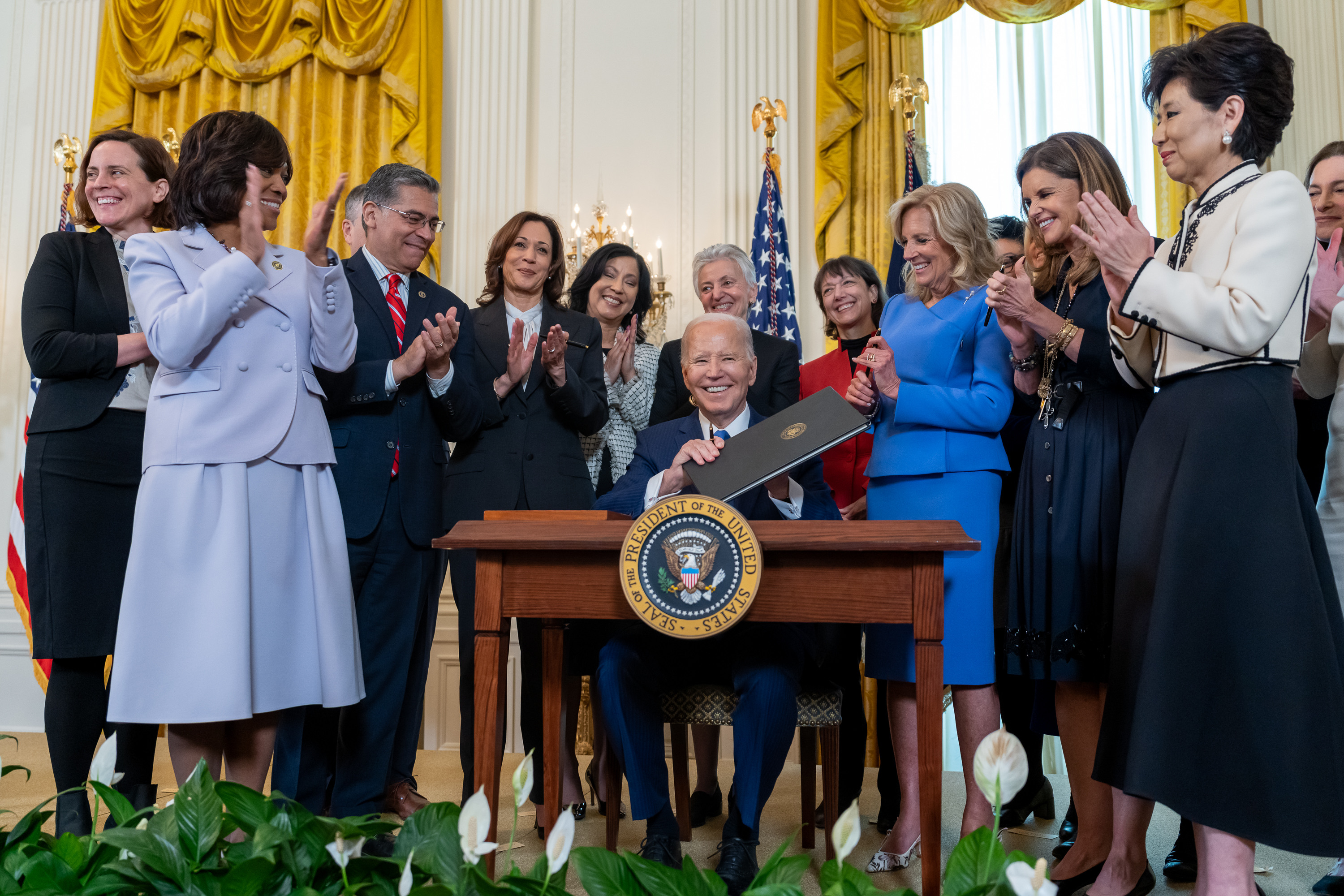President Biden Issues Executive Order on Advancing Women’s Health Research and Innovation
On March 18, 2024, President Joe Biden signed a new Executive Order (EO) that builds upon the establishment of the White House Initiative on Women’s Health Research. This EO announces new actions to improve women’s health research by prioritizing investments in women’s health research, integrating women’s health across the federal research portfolio, galvanizing new research on women’s midlife health, and assessing the unmet needs to support women’s health research. ORWH Director Janine Austin Clayton, M.D., FARVO, and Deputy Director Vivian Ota Wang, Ph.D., were honored to attend the historic signing alongside NIH Director Monica Bertagnolli, M.D., and Deputy Director for Program Coordination, Planning, and Strategic Initiatives Tara A. Schwetz, Ph.D.
“It’s important now more than ever that women’s health research be considered a priority, not an afterthought. Accelerating women’s health research is vital because data shows that sex and gender affect health at all levels – and there is tangible evidence that indicates when you invest in the health of women, it benefits society at large. President Biden’s historic Executive Order will ensure that women’s health is prioritized across the federal research portfolio and further ORWH’s mission of transforming knowledge into impact to improve the health of all women.” –Dr. Janine Austin Clayton
The EO focuses on five key areas of support and advancement, to which a variety of federal agencies have offered their commitment. A sampling of the federal support that has been pledged to date is presented below.
- Prioritize and Increase Investments in Women’s Health Research: NIH has pledged $200 million to launch an NIH-wide effort to close gaps in women’s health research across the lifespan, such as on the impact of perimenopause and menopause on heart health, brain health, and bone health. ORWH is honored to co-chair this NIH-wide effort alongside the National Institute on Aging (NIA); the National Heart, Lung, and Blood Institute (NHLBI); the National Institute on Drug Abuse (NIDA); the Eunice Kennedy Shriver National Institute of Child Health and Human Development (NICHD); and the National Institute on Arthritis and Musculoskeletal and Skin Diseases (NIAMS). This effort will invest in research on a wide range of women’s health issues, call for new proposals to research emerging women’s health issues, and study the effect of environmental factors on women’s health. Further, NIH has identified a lack of awareness among researchers about federal funding opportunities as a potential barrier to women’s health research. In response, NIH issued a new Notice of Special Interest (NOSI) to identify open funding opportunities related to women’s health research across a wide range of health conditions. ORWH is committed to creating a dedicated, consolidated, one-stop shop that aligns researcher and institution interest with funding opportunities across each of NIH’s 27 institutes.
- Foster Innovation and Discovery in Women’s Health: To foster and accelerate innovation, the Advanced Research Projects Agency for Health (ARPA-H) is launching a Sprint for Women’s Health that will commit $100 million in funding to transformative research and development (R&D) in women’s health. NIH also plans a 50% increase in its investment in private-sector innovators and small businesses engaged in R&D on women’s health. Another new NIH initiative will focus on biomarker research to help improve early detection and treatment of conditions that uniquely affect women, such as endometriosis. The National Science Foundation is also committed to leveraging engineering research to improve women’s health and drive innovations in new directions using tools such as biomechanics and immune-engineering.
- Expand and Leverage Data Collection and Analysis Related to Women’s Health: To identify and develop new common data elements related to women’s health, NIH is launching an effort that will promote interoperability and improve data accuracy. The Centers for Disease Control and Prevention plans to improve its analysis and reporting of women’s health information by expanding the collection of key quality measures across a woman’s lifespan.
- Strengthen Coordination, Infrastructure, and Training to Support Women’s Health Research: The Department of Defense and Department of Veterans Affairs are launching a joint Women’s Health Research effort to improve their coordination of evidence-based care for Service members and Veterans. The Environmental Protection Agency is establishing a Women’s Health Community of Practice to support research and dissemination of data on the intersection of environmental factors and women’s health.
- Improve Women’s Health Across the Lifespan: NIH has created the first-ever Pathways to Prevention (P2P) series on menopause and the treatment of menopausal symptoms. P2P is an independent, evidence-based process that will identify gaps in existing research and develop a roadmap to move the research forward. Additionally, the Indian Health Service will offer a series of engagements to promote the health of American Indian and Alaska Native Women, including by better understanding the relationship between tribal beliefs and menopause.
“We at ORWH are thrilled to receive Presidential recognition and support for women’s health research. This Executive Order validates the essentialness of women’s health research and ensures that we continue to make strides in extraordinary and innovative scientific discoveries, advances, and contributions to the women’s health research landscape.” –Dr. Vivian Ota Wang
Visit the White House Briefing Room for more information on the Executive Order.

